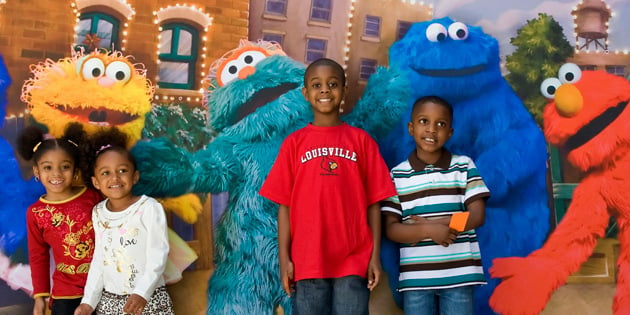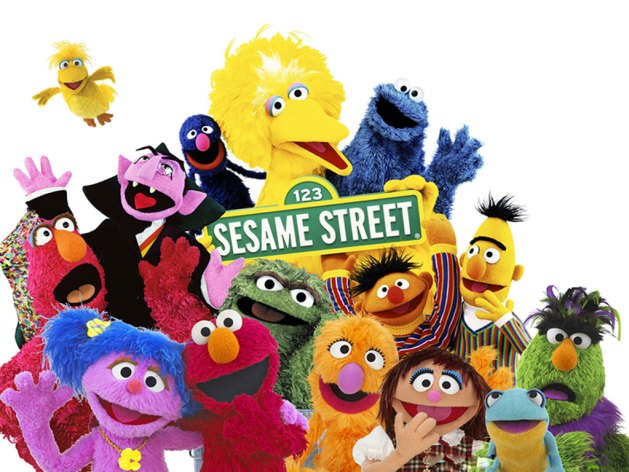Sesame Street‘s 46th Season (46!) debuts in its new home on HBO on Saturday morning, and if you’ll be watching with your kids, you may notice that the look and feel of the show will be a little less what you remember, and a little more Farmer’s Market in Williamsburg.
The New York Times recently did a profile on the new season, including some behind-the-scenes photos, and this new Sesame Street is geared to more modern children. Some of the changes to the show make a lot of sense. Others aren’t as inclusive of all children as they could be.
Changes That Make Sense:
- There will be fewer celebrity appearances and parodies. Because let’s be honest, those were really for the parents anyway. Sesame Street is all about its target audience now, and that’s a good thing. However, there will still be some celebrity appearances, so Sesame Street remains a goal to shoot for that will let celebrities know when they’ve officially Made It. Oh, and “Orange is the New Snack” is an upcoming parody about bringing healthy snacks to school.
- Season 46 will focus on Kindness. Who couldn’t use more of that? For example, in the upcoming episode “The Best Friend Band,” Elmo and Abby Cadabby start a band and try to play “Twinkle, Twinkle, Little Star,” but have trouble getting it together. In the end, they have to learn to compromise.
- The sets have been updated to reflect a more current urban environment. If you look at at the photo of the new Hooper’s Store, you’ll see that it looks more like a New York City store front, which is really cool. City kids will see something out of their lives, and those not from a city will get a positive impression of what it’s like to live in one.
- The show will be a half hour, instead of one hour. This definitely makes sense. I remember when I was a kid, I would inevitably wander away from Sesame Street to go play after a while (usually during the Muppet-free portions). A shorter show is easier for a pre-school age child to digest, and the increased focus should make for better learning.
Changes That Make Less Sense:
- Less emphasis on classic characters. While characters like Big Bird, Mr. Snuffleupagus, Oscar the Grouch, Burt, and Ernie will make appearances, the stories will focus more heavily on younger characters like Elmo, Cookie Monster, and Abby Cadabby, supposedly in the interest of giving children “familiar faces each week.” I have mixed feelings about this. One the one hand, a great thing about Sesame Street is that, since it’s so long-running, their human cast ages (and in the case of Mr. Hooper, dies), giving children an opportunity to learn about change and loss. So, perhaps weaning children off of the presence of those classic characters in favor of the younger ones makes sense. On the other hand, Big Bird and the rest are staples of Sesame Street, and could be a constant in childrens’ lives as well.
- Elmo lives in a brownstone. Here’s where I start to have trouble. According to the Times piece, a lot of the changes that are being made so that the show looks – as Carmen Osbahr, the voice of Rosita says – “like things look now.” She goes on, “When Sesame Street was created, it was kind of more like New York Bronx. Now, Oscar has a recycling can. That is amazing.” Thing is…what’s wrong with “New York Bronx?” That still exists, and the kids who live there still exist. Sesame Street has always been about bringing educational programming to children with less access. Now, not only will the show exclusively be on HBO for nine months before the episodes go to PBS, but the vibe of the show is seemingly more designed to appeal to the white, upper-middle-class children of hipsters, possibly making poorer children feel like they don’t have a place on Sesame Street.
- The new theme sequence is getting a new spin, and will be filmed entirely on the show’s set. The theme has changed a lot over the years, but one of the strengths of Sesame Street used to be its connection to real-life kids. Anyone could get to Sesame Street, and the show opening on kids actually out in New York City really made it seem possible.
I’m all for updating Sesame Street for the kids currently watching it. This isn’t the place for nostalgia, as the purpose of the show is to be educational for today‘s children, and what will work best for them should be top priority. However, I hope that while they’re being taught kindness, they’re also being taught that not everyone can live in a brownstone, or has the ability to compost, or access to a farmers’ market. I hope that the new Sesame Street won’t inadvertently reinforce class stereotypes and a disdain for anything “old.”
What do you all think? Will you and your kids be watching the new Sesame Street?
(image via The USO/Flickr)
—Please make note of The Mary Sue’s general comment policy.—
Do you follow The Mary Sue on Twitter, Facebook, Tumblr, Pinterest, & Google +?










Published: Jan 13, 2016 07:45 pm